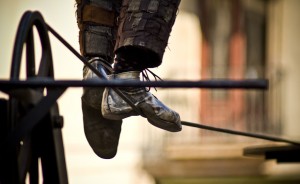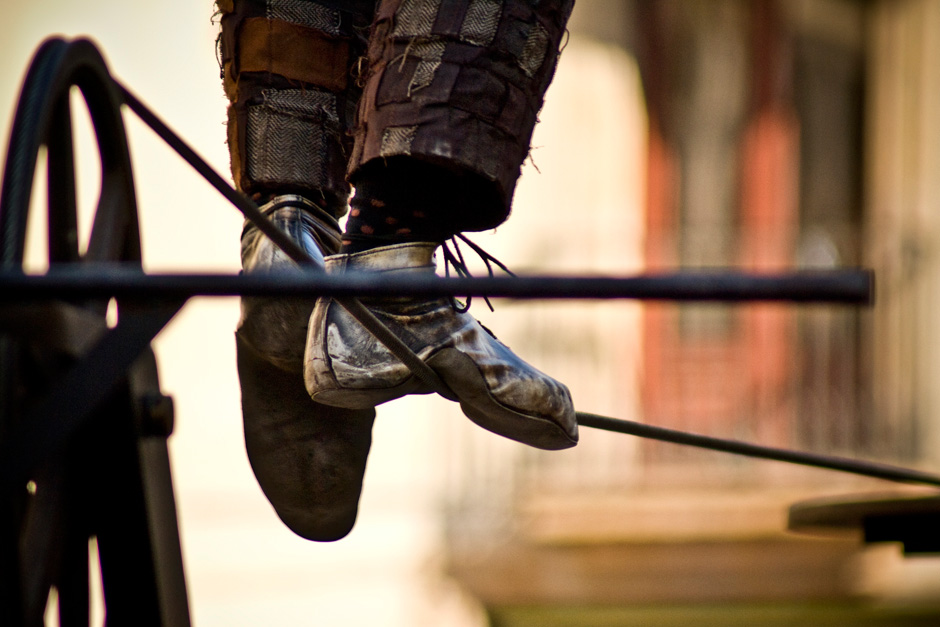
Licensed under CC BY-SA 2.0 via Wikimedia Commons
I have remarked before on this blog that what we call “balance” is really more a range than a fixed point. That is to say, balance is achieved not so much by staying still on a fixed point as by moving within a range around that point. The videos below feature unicyclists and tightrope walkers. The tightrope walker only survives by being able to move within a very narrow range. The same is true and even more visible with the unicyclists—the moment they stop moving, they will fall.
And in this is a picture of virtue. What is virtue? Virtue is the habit of doing good. St. Thomas Aquinas, basing his view on those of Aristotle, spoke of virtue as the mean between excess and defect. An old Latin saying comes to mind: in medio stat virtus (virtue stands in the middle).
The virtuous act is one that is neither excessive nor deficient. So, for example courage is neither foolhardy nor cowardly, and temperance is neither total abstinence nor gluttony. Humility is neither arrogance nor subservience. Perseverance is neither obstinacy nor capitulation (Art and Laraine Bennett, The Emotions God Gave You: A Guide for Catholics, p. 83).
Thus, the balance of the virtues is not something that freezes us, but rather is better described as a range of motion around the golden mean.
It is true that in highly specific moral acts or settings, there is often only one valid choice, e.g., in cases of abortion, fornication, and murder. But virtue here is understood more broadly as a general and habitual way of acting in accord with right reason.
Understanding virtue as the mean or midpoint between excess and defect is important for two reasons.
First, it helps us to avoid being overly scrupulous. In life there is often a range of possibilities available to us and we need some flexibility to be able to handle the unique circumstances of each moment. We must act within a range of responses that respect what faith and reason require. Scrupulosity often causes people to focus on a single aspect. Without balance, the flexibility necessary to move in a morally graceful way is limited.
Second, because life is made up of many complex things that come together in varying combinations, it is not reasonable, possible, or wise for the Church or Scripture to speak to every possible moral topic and scenario. What the Church and Scripture do most frequently is to give us principles to apply along with virtue.
There are many critics of the Church and of religion in general who are dismissive of rules and “micromanaging” by Church authorities. Of course there are some rules (there are rules in every walk of life). But more important, there are principles to be applied. It is quite impossible for the Church to micromanage every situation or have a rule for every possible situation. The dignity of Catholics is respected by the Church. She teaches us, but then expects us to use our intellect and reason to apply her principles virtuously, that is, with neither excess nor defect.
Just brief reflection on virtue.
As you view these videos, notice how balance is less a fixed point and more a range of motion. Further, if the artist is not able to move within a range and adjust to circumstances moment by moment, disaster is sure to follow. Virtue is moving and acting within the golden mean, within the range of neither excess nor defect. Virtue is a form of balance.
In this second video it is clear that the tightrope walker’s range of motion is much narrower, but still he must be able to move within that range to adjust to circumstances. I also want to say that I am not even sure that tightrope walking is a moral activity. In showing this video I do not affirm taking needless risks (though I know they train well). The reason I use this video is just to illustrate the point. The morality of tightrope walking is uncertain to me, but I’m inclined to lean against it. 😉


Well, Msgr., I hope I can learn from you. As you said; by Faith, not by sight. Have a great weekend!
Those were both neat videos. It would take a long time to learn those tricks those young women did even without the unicycles thrown in and they showed a lot of inventiveness. I lean too toward tight rope walking being too dangerous.